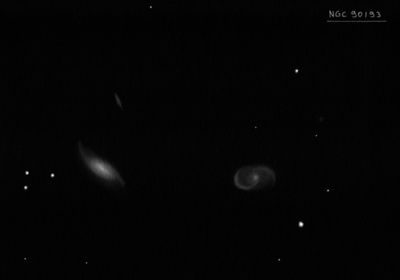
R.J. Mitchell discovered NGC 90 using Lord Rosse's 72" on 26 Oct 1854. The description mentioned "Several S; F neb visible at once in finder" so JH assumed at least 3 objects were discovered, which he catalogued as GC 40, 41, 42. But a sketch of the NGC 90 field shows only two nebulae labeled as Alpha (now NGC 90) and Beta (now NGC 93). Herman Schultz observed the field on 17 Oct 1866 with the 9.6" refractor at Uppsala and measured an object he thought was GC 40, but was actually Mitchell's Alpha. His micrometric position matches UGC 208 = PGC 1405. Because of an uncertainty in the position and identification, Dreyer catalogued this object as GCS 5096 with the comment "Query = GC 40, 41, 42?". Dreyer equated GC 40 = 5096 in the NGC.
Modern catalogues misidentify UGC 208 as NGC 91 but Schultz's position for NGC 91 falls precisely on a very faint star 1.9' S. This misidentification may have originated in Curtis' description of nebulae (1918) based on Crossley photographs at Lick observatory. See Corwin's notes for further discussion.
300/350mm - 13.1" (9/29/84): very faint, elongated NW-SE. A mag 13 star is 1' SW.
400/500mm - 17.5" (9/19/87): very faint, small (only the central portion of the galaxy observed), slightly elongated, weak concentration. A mag 12 star is 1.3' SW. Forms a pair with NGC 93 2.8' E. Located on the east side of the NGC 80 group 7.0' ESE of NGC 83.
900/1200mm - 48" (10/30/16): at 488x and 610x; bright, oval 3:2 E-W, sharply concentrated with a very bright roundish core (slightly elongated at 610x) and a fairly large oval halo, ~60"x40". A spiral arm is visible on the northwest side, curling clockwise to the south but the long, thin tidally stretched extensions to the northwest and southeast were not seen. Forms a striking (interacting) pair with NGC 93 2.8' ENE. A mag 12 star is 1.3' SW. Although this galaxy is often identified as NGC 91, that number applies to a mag 14.8 star 1.9' S.
NGC 90 = Arp 65 was classified as a Spiral galaxy with small, high surface-brightness companions on arms. LEDA 1669552, the "companion" just beyond the northwest tidal extension (2.4' NW of NGC 90), appeared faint (V ~17.1), small, elongated 3:2 N-S, 10"x6". A mag 15.7 star is 30" SE. No redshift is available on this object, so it may lie far in the background.
Notes by Steve Gottlieb